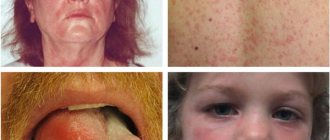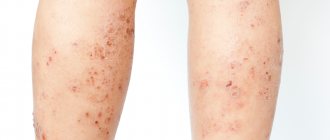The prevalence of food allergies in infants, according to WHO, is about 10%. This is a fairly large percentage and recently there has been a tendency towards its growth. It’s not uncommon to encounter a mother in the pediatrician’s office complaining of food allergy symptoms in her baby. To effectively treat food allergies in infants, the doctor must try not only to prescribe medications, but also to explain the rules for caring for the baby and explain the intricacies of diet therapy.
In the development of allergies, hereditary predisposition is of great importance. Therefore, if mom or dad have allergic reactions, then the baby’s risk of developing food intolerance becomes higher.
Symptoms of food allergies in infants
1. Manifestations of food allergies are varied. The most common manifestation is a rash. Immediately after an allergen enters the body, an acute allergic reaction—urticaria—may develop. Bright red swollen spots of different sizes and shapes appear on the baby’s skin. A bubble with transparent contents may appear in the center of the spot. Its size can vary from a few millimeters to several centimeters. This rash usually goes away within 1-3 days. But it’s still worth showing the baby to the doctor. Since sometimes a child needs medication, and in case of an extensive rash, or its unfortunate location, even emergency help. You need to remember which product caused this reaction and not give it again.
2. Other types of rash are not as severe. Therefore, it is not always possible to determine a clear connection between its occurrence and the product. Such rashes are usually not bright, small-pointed. They are prone to undulating flow. The rash usually becomes brighter in the evening and fades in the morning. The skin becomes dry, flaky, and sometimes cracks. Most often, such a rash is located on the cheeks, buttocks, outer surfaces of the thighs and forearms. This type of rash requires special attention from specialists - examination and specific treatment.
3 The second most common manifestations are gastrointestinal symptoms. These include: swelling of the mucous membranes of the oral cavity, swelling of the esophagus, single or repeated vomiting. Most often, such symptoms appear acutely, immediately after consuming the allergen. In addition, the baby may experience abdominal pain. He can groan, be capricious, and kick his legs. Food allergies can manifest as loose stools. This can be either diarrhea or constipation. Less obvious signs of a food allergy in a baby may include frequent heavy regurgitation, low weight gain, poor appetite, and weakness. Manifestations from the gastrointestinal tract may occur with or without a rash.
4 Much less often in infancy, manifestations from the respiratory system are possible; if food gets into the mucous membranes, swelling of the upper respiratory tract may occur. This condition is acute and life-threatening. It requires immediate medical attention. With prolonged contact with the allergen, allergic rhinitis or asthma may develop. More often, such reactions appear not after ingestion of food, but after inhalation of its particles. The most common cause of respiratory allergies is inhalation of fumes from cooking or frying fish.
In addition, there are severe acute allergic reactions such as angioedema or anaphylactic shock. Such reactions occur immediately after contact with the allergen and develop very quickly. They are extremely rare and require emergency medical attention.
Features of the rash with prickly heat
Miliaria in children occurs when the skin is irritated as a result of excessive sweating. The reason lies in the imperfection of thermoregulation and the structural features of children's sweat glands, which have narrow excretory ducts.
The rash most often appears during the hot season, as well as during the cold season in children who are overly wrapped up. Skin rashes, triggered by increased sweating, occur when the temperature rises during illness or thermal procedures.
The causes of prickly heat can be:
- incorrectly selected baby clothes, in which he sweats a lot;
- increased room temperature, especially if heaters that dry the air are used;
- failure to comply with hygiene standards, as a result of which the baby may experience blockage of the sweat glands.
You can distinguish heat rash from allergies in newborns by a rash that looks like bright red or flesh-colored blisters (papules). Bubbles appear in any area, but the typical localization is usually in closed areas of the back, buttock folds, neck, armpits, between the buttock folds, as well as on the face and abdomen. They usually appear immediately after the child overheats.
To get rid of the rash, dry it with baby powder. If the rash is caused by sweat, the blisters will disappear the next day. We are talking about prickly heat, which is already a priori associated with sweat, or rather with difficulty in sweating. You should not use powder, ointments and creams, but rather use baths, but with a low temperature, you can also consider the following: Normalize the temperature and humidity conditions in the room, change linen more often, use cotton fabric, try not to overheat the child.
Causes of food allergies in newborns
Food allergies in babies who have just been born are very rare. The baby receives only mother's milk. This is food that nature created for your baby and nothing can be better than it. Therefore, the peak age of food allergies in breastfed infants can be considered around 4–5 months, when the baby begins to receive complementary foods - products added to breast milk: vegetables, fruits, cereals, meat, dairy products and others. The situation is somewhat different with bottle-fed babies. The formula itself can cause food intolerances. Therefore, when choosing a mixture, it is better to consult a specialist.
What is the most common allergen in infants?
1. The first place is occupied by intolerance to cow's milk protein. It should be noted that most modern formulas for feeding infants are based on cow's milk proteins. This is the reason why the baby is allergic to the formula. In addition, a breastfed baby can also have a reaction to cow's milk protein if the mother has an excess of dairy products in her diet. We are not talking about a specific component of milk or formula. Cow's milk contains many different proteins: albumins, globulins, casein. Some of them cause an allergic reaction more often, others less often. Casein makes up about 80% of all milk proteins. Its composition in cow's milk is identical to that of goat's. This explains the cross-reaction in babies to cow's and goat's milk. Therefore, if you are intolerant to cow's milk, it is not recommended to replace it with goat's milk, or mixtures based on goat's milk, in the child's diet. Some proteins are destroyed by heat treatment. This is due to the lower reactogenicity (ability to cause reactions) of boiled milk. There is a protein similar in composition to the protein of beef or veal meat. If the baby is intolerant to this type of protein, there will be a cross-reaction to milk and meat products.
2. The next most common cause of allergies in an infant is a chicken egg. The egg also contains a protein called ovalbumin that is an allergen. Therefore, it is recommended to start introducing eggs into the diet with the yolk and in small portions. Watch your baby's reaction to this product carefully. When feeding eggs and protein for the first time, you should also carefully monitor the reaction. Don't forget that eggs are found in some pasta and baked goods.
3. Gluten is a common cause of food intolerance. This is a protein found in some grains. In order to prevent an undesirable reaction, it is recommended to start complementary feeding with gluten-free cereals. These include: buckwheat, corn, rice. Cereals rich in gluten, such as semolina, millet, and oatmeal, should be introduced closer to the age of one. In the first year, a reaction to gluten is less common than intolerance to cow's milk protein or egg white.
4. In addition, brightly colored fruits and vegetables can cause food reactions. Such as carrots, beets, pumpkin, peach. It is better to postpone their introduction into the diet and give preference to green and white vegetables - such as zucchini, cauliflower and broccoli. It’s best to start introducing your baby to fruits with green apples and pears. It is also better not to rush with exotic fruits such as mango or kiwi.
Do not forget that an allergic reaction is possible to any product. When giving a treat to a baby for the first time, a mother should remember the risk of intolerance. Try not to rush, especially with the introduction of the very first complementary foods. Give unfamiliar foods to the child in small portions in the morning so that it is possible to control the reaction to them throughout the day.
How to recognize a food allergy and not confuse it with other diseases?
Most often, in order to diagnose a food allergy, a doctor only needs an examination and a detailed interview with the mother. Mom can point out that she herself has a food allergy or point the doctor to a specific food. Sometimes it is difficult to make such a diagnosis right away. Then the doctor may order an examination. First, a general blood test. And then, if necessary, specific allergy tests: examination for immunoglobulins, and at a later age, provocative tests. It is these tests that were chosen as the most informative in the latest clinical recommendations. In addition, your baby may need to consult an allergist, dermatologist or gastroenterologist, depending on the symptoms that are bothering him. And also, additional examination from the gastrointestinal tract.
Diagnostic methods
If you suspect an allergy, you should contact your pediatrician, who, after conducting an initial examination, will refer the child to an allergist. And already there the doctor will prescribe all the necessary procedures that will help to understand exactly what kind of allergic reaction the child has and what it is. These include skin tests and blood tests for general and specific IgE. As well as provocative tests with the application of a drug with an allergen to the mucous membrane of the eyes, nose, respiratory tract, orally. Naturally, this study is carried out only under the supervision of a doctor.1,4
Treatment and prevention of allergies
According to the latest WHO recommendations, the basis for the prevention of food allergies in children is breastfeeding. Children who receive exclusively breast milk in the first months of life are much less likely to suffer from food allergies. At the same time, mothers of healthy children who are breastfed do not require special diets. Their diet should be complete and varied, including proteins, fats, and carbohydrates. As well as microelements and vitamins. Mothers of children who are at risk for food intolerance are advised not to limit their diet too much. It is necessary to completely exclude those foods to which the mother herself has a reaction and keep a food diary.
If artificial feeding is necessary, children prone to allergies choose special hypoallergenic formulas. To treat existing manifestations, the mixture should be selected by a specialist. According to the latest clinical recommendations, if you are intolerant to cow's milk protein, choose mixtures with fully hydrolyzed protein or amino acid composition. In this case, it is not correct to prescribe hypoallergenic mixtures and mixtures based on goat’s milk protein. Soy-based mixtures themselves can cause an allergic reaction.
Another important step for the prevention and treatment of food allergies is the correct introduction of complementary foods. Complementary foods should be introduced in a timely manner - no earlier than 4 months and no later than 6. To begin with, hypoallergenic foods are selected - white and green vegetables, gluten-free cereals. On one day, the baby is given only one complementary food product, in small quantities, and the possible reaction is observed. At the beginning, a new product should be introduced no more than once a week. Mothers of babies who are predisposed to allergies or already have allergic manifestations are recommended to keep a food diary. There, the mother writes down all the foods she fed the child during the day and possible reactions to them.
The doctor, if necessary, can prescribe medications to the baby. They can be either for oral administration or for skin treatment. Children with chronic allergic rashes require special skin care. It is necessary to use special children's detergents with a neutral pH. And after washing, use special care products - emollients. It is better to consult a doctor about which emollient to choose. If there are manifestations from the gastrointestinal tract or respiratory system, the child needs specific treatment, which can only be prescribed by a doctor during an in-person examination.
Online consultation with a pediatrician
Online consultation
During the consultation, you will be able to voice your problem, the doctor will clarify the situation, interpret the tests, answer your questions and give the necessary recommendations.
How long do food allergies last in infants?
Children with food allergies have an increased risk of other allergic reactions or illnesses in the future. There is also a chance that intolerance to the product will remain with the baby for life. However, up to 50% of allergic reactions in babies go away by the age of one year. And up to 90% by 5 years. Most of the patients I have worked with at 3 years old go to kindergarten without any manifestations of the disease.
It is possible to protect your child from food allergies by paying close attention to his diet and the mother’s diet during breastfeeding. And if allergies cannot be avoided, contact a specialist and be healthy.
Course of allergy
- Allergies in children can develop instantly - for example, in the case of an ant bite - or over several months, as happens when it is caused by cat fur or pollen. It all depends on how often the child comes into contact with the allergen.
- Seasonal allergies occur every year in the spring, summer and fall, and mold allergies can develop if there is prolonged rain outside and humidity levels in the home have increased, leading to the growth of microorganisms.
- It is important to understand that allergies in children can come and go, and there is no exact explanation for this.








